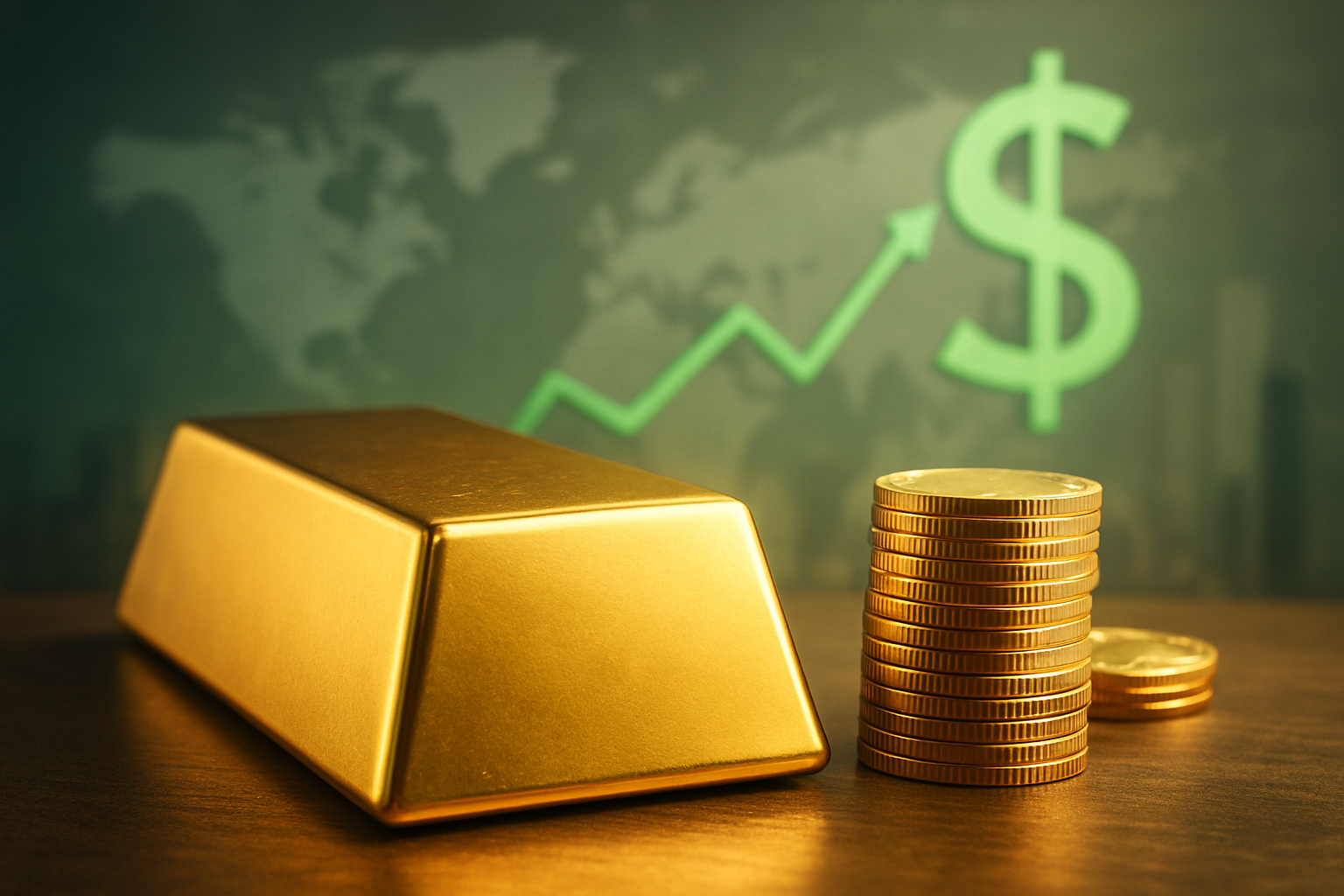
As of October 30, 2025, the financial world watches with keen interest as gold prices aggressively test the psychological $4,000 per ounce barrier, a remarkable display of resilience that defies conventional market wisdom. This impressive ascent comes even as the US dollar has shown renewed strength, creating a complex and intriguing dynamic for investors. Gold's sustained upward momentum signals a profound shift in market sentiment, positioning the precious metal as a cornerstone asset in an era defined by economic uncertainty and evolving geopolitical landscapes.
The immediate implications are far-reaching, hinting at a recalibration of investment strategies across various sectors. While a stronger dollar typically acts as a headwind for dollar-denominated commodities like gold, the current environment sees gold thriving, driven by a confluence of factors including aggressive monetary easing expectations, robust central bank demand, and persistent global instability. This divergence suggests that traditional correlations are being challenged, forcing analysts and investors alike to re-evaluate gold's role as both a safe-haven and a growth asset.
A Golden Rally: Dissecting Gold's Unprecedented Surge
Gold's journey to the cusp of $4,000 an ounce has been nothing short of spectacular throughout 2025. Currently trading around $3,998.37 per troy ounce, the precious metal has not only briefly surpassed the $4,000 mark but also reached an all-time high near $4,381.58 earlier in the year before a period of consolidation. This rapid appreciation translates to year-to-date gains approaching an astounding 50%, with its price soaring 45.57% compared to this time last year. The speed of this rally is particularly noteworthy, with gold climbing from $3,500/oz to $4,000/oz in a mere 36 days, setting 13 new all-time highs in the third quarter of 2025 alone.
This bullish trend unfolds against a backdrop of a recently strengthened US Dollar Index (DXY), which measures the dollar against a basket of major currencies. On October 30, 2025, the DXY rose to approximately 99.25-99.5, extending gains for a second consecutive session. This dollar uptick was primarily fueled by a positive outcome from the US-China trade summit and a cautiously hawkish stance from Federal Reserve Chair Jerome Powell regarding future interest rate cuts. However, this short-term dollar strength masks a broader trend, as the US dollar's value has experienced a 4.25% decline over the last 12 months, indicating underlying pressures.
The paradox of gold's surge alongside a strengthening dollar is attributed to several powerful, converging forces. Firstly, expectations of aggressive monetary easing, despite the Federal Reserve's (The Fed) recent 25-basis-point interest rate cut and Chair Powell's less dovish remarks, continue to underpin gold's appeal. Lower interest rates generally reduce the opportunity cost of holding non-yielding assets like gold. Secondly, global central banks remain voracious buyers, accumulating 220 tons in Q3, a 28% increase from the previous quarter, signaling a strategic diversification of reserves. Thirdly, persistent geopolitical fragmentation, ongoing trade tensions, and domestic issues such as a prolonged US government shutdown are driving investor demand for safe-haven assets. Lastly, de-dollarization efforts and lingering inflation risks further cement gold's role as a hedge against economic instability and eroding purchasing power, creating a "structural shift" in its market behavior.
The immediate market reactions have been varied. Gold market volatility is expected to persist around the $4,000 level, with potential for profit-taking. Equity markets, surprisingly, have seen new highs concurrently with gold, suggesting institutional investors view gold as a complementary asset. Gold mining companies, such as Barrick Gold (NYSE: GOLD) and Newmont (NYSE: NEM), are direct beneficiaries, anticipating increased revenues and expanded profit margins. In the bond markets, the Fed's rate cut was largely priced in, but Powell's comments have pushed the 10-year Treasury yield above 4%, tempering expectations for aggressive further cuts. Currency markets face headwinds for gold from the dollar's recent strength, yet the long-term trend of dollar weakness and de-dollarization efforts continue to provide support.
Corporate Fortunes: Winners and Losers in the Golden Era
The sustained rally in gold prices to near $4,000 per ounce is creating clear winners and losers across the corporate landscape, particularly within the mining sector and among companies sensitive to macroeconomic shifts. At the forefront of the beneficiaries are gold mining companies, whose profitability is directly tied to the price of the precious metal. Companies like Barrick Gold (NYSE: GOLD) and Newmont (NYSE: NEM) are experiencing significantly expanded profit margins as their cost of extraction remains relatively stable while the value of their output soars. This windfall enables them to invest in exploration, expand existing operations, reduce debt, and return capital to shareholders through dividends or buybacks, making them attractive to investors seeking direct exposure to the gold boom. Mid-tier and junior miners also stand to gain, as higher gold prices can make previously uneconomical deposits viable, potentially leading to increased production and M&A activity within the sector.
Beyond direct gold producers, precious metals streaming and royalty companies also benefit immensely. Firms such as Franco-Nevada Corporation (NYSE: FNV) and Wheaton Precious Metals Corp. (NYSE: WPM), which provide upfront financing to miners in exchange for a percentage of future production or revenue, see their existing contracts become significantly more valuable without incurring additional operational costs. Their business model offers leveraged exposure to rising commodity prices with reduced operating risks, making them particularly appealing during periods of strong gold performance.
Conversely, companies that might face headwinds or see their appeal diminish include those whose business models thrive on a stable or strengthening economy with low commodity prices. Industries that rely heavily on raw materials, where gold's rise might signal broader inflationary pressures, could see increased input costs. While not directly impacted by gold's price, companies heavily exposed to interest rate hikes could suffer if the Federal Reserve were to pivot aggressively to combat inflation, making borrowing more expensive. However, given the current narrative of monetary easing expectations, this risk is somewhat mitigated for now. Furthermore, companies with large dollar-denominated debt could see a relative easing of their debt burden if the dollar continues its long-term weakening trend, but a short-term strengthening could pose challenges for those with unhedged foreign currency exposures.
Another category of potential losers includes financial institutions heavily invested in traditional fixed-income assets that may be less attractive in an environment where investors are flocking to gold as an inflation hedge or safe haven. While not a direct loss, the opportunity cost of not being invested in surging gold-related assets could impact their overall portfolio performance. The "de-dollarization" trend, partially driven by gold's appeal, could also subtly impact companies that benefit from the dollar's historical global dominance, though this is a longer-term, systemic shift rather than an immediate corporate impact.
Wider Significance: A Paradigm Shift in Global Finance
The sustained strength of gold, particularly its ability to test $4,000 an ounce amidst a robust US dollar, signifies more than just a commodity rally; it points to a profound paradigm shift in global financial markets. This event is deeply embedded within broader industry trends, most notably the ongoing de-dollarization efforts by central banks and sovereign wealth funds. Many nations are actively seeking to diversify their reserves away from the US dollar, viewing gold as a neutral, sanctions-proof asset. This strategic pivot reduces reliance on any single fiat currency and provides a tangible hedge against geopolitical risks and currency fluctuations, accelerating a trend that has been simmering for years.
The potential ripple effects on competitors and partners are substantial. For other safe-haven assets, such as certain government bonds, gold's allure could diminish their relative attractiveness, potentially influencing capital flows. In currency markets, while the dollar has shown recent strength due to specific catalysts, gold's long-term upward trajectory, coupled with de-dollarization, could contribute to a gradual erosion of the dollar's global reserve currency status over time, impacting trade and investment patterns. Partners of nations actively pursuing de-dollarization might also explore alternative settlement mechanisms and reserve assets, fostering a more multipolar financial system.
Regulatory and policy implications are also noteworthy. Governments and central banks globally are closely monitoring gold's performance. Should the trend of rising gold prices and de-dollarization accelerate, it could prompt discussions around international monetary policy, reserve management guidelines, and even the role of gold in future financial frameworks. For instance, if gold is increasingly seen as a primary hedge against inflation, central banks might face additional pressure to manage inflationary expectations more aggressively or reconsider their own gold holdings. The current environment, marked by geopolitical fragmentation and trade tensions, further underscores the strategic importance of national gold reserves.
Historically, gold has often moved inversely to the US dollar, serving as a hedge against dollar weakness and inflation. However, the current scenario presents a compelling historical precedent for gold's ability to thrive even when the dollar is firm. Similar periods of concurrent strength, though rare, have typically occurred during times of heightened global uncertainty, aggressive monetary expansion, or significant structural shifts in the global financial order. For example, during certain phases of the 1970s and early 2000s, gold demonstrated resilience against a relatively strong dollar amidst energy crises and dot-com bust respectively, driven by inflation fears and geopolitical instability. This current period, marked by central bank buying and de-dollarization, suggests a new, perhaps more structural, driver for gold's performance, challenging the traditional inverse correlation and signaling a deeper investor demand for tangible assets.
The Road Ahead: Navigating Gold's Future Trajectory
Looking ahead, gold's performance near the $4,000 mark sets the stage for a fascinating and potentially transformative period in financial markets. In the short term, expect continued volatility around this psychological barrier. While the bullish momentum is strong, periods of profit-taking are likely, especially following such a significant rally. Technical resistance levels near $4,016 and $4,060 will be closely watched, with support expected around $3,950 and $3,886. The Federal Reserve's future commentary on interest rates and inflation will also play a crucial role, as any perceived shift towards a more hawkish stance could introduce temporary headwinds by strengthening the dollar or increasing the opportunity cost of holding gold.
The long-term possibilities for gold appear robust. Analysts at the 2025 LBMA Global Precious Metals Conference have projected gold could test $4,980 to $5,000 per ounce by next year, suggesting substantial upside potential. This optimistic outlook is underpinned by the enduring factors of central bank demand, ongoing de-dollarization efforts, and persistent global geopolitical and economic uncertainties. Should these trends continue, gold's role as a core strategic asset in diversified portfolios will only solidify.
Potential strategic pivots or adaptations will be required across various market participants. Investors may need to re-evaluate their asset allocation strategies, potentially increasing their exposure to gold and gold-related equities as a hedge against systemic risks and inflation. Central banks are likely to continue their accumulation, further reinforcing gold's price floor. For public companies, particularly in the mining sector, the sustained high price environment presents significant market opportunities. They can leverage increased cash flows for expansion, technological upgrades, and sustainable mining practices. However, challenges such as rising input costs and environmental regulations will also need careful navigation to maintain profitability.
Several potential scenarios and outcomes could unfold. In a "bull case," escalating geopolitical tensions or a significant acceleration in global de-dollarization could push gold well beyond $5,000, potentially even higher if inflation becomes a more pronounced global issue. In a "base case," gold continues its gradual ascent, maintaining its safe-haven status and benefiting from consistent central bank buying and moderate inflation concerns. A "bear case," though less likely given current trends, would involve a dramatic and sustained strengthening of the US dollar, coupled with a significant de-escalation of global tensions and a clear path to higher interest rates without inflation, which could lead to a pull-back. However, the prevailing sentiment and underlying drivers strongly favor continued upward pressure on gold prices.
A Golden Horizon: Key Takeaways and Investor Outlook
The current performance of gold, testing $4,000 per ounce despite a strong US dollar, marks a pivotal moment in financial markets. The key takeaway is that traditional correlations are evolving, with gold demonstrating a newfound resilience driven by structural shifts rather than solely inverse dollar movements. This resilience is fueled by aggressive monetary easing expectations, insatiable central bank demand, pervasive geopolitical uncertainty, and a growing global trend towards de-dollarization. Gold is no longer merely a crisis hedge; it is increasingly viewed as a fundamental component of diversified portfolios, offering protection against both inflation and systemic risks.
Moving forward, the assessment of the market suggests that gold will likely remain a highly relevant and sought-after asset. Its ability to perform well during periods of both "risk-on" and "risk-off" sentiment underscores its unique position. While short-term volatility around the $4,000 level is anticipated, the underlying drivers point to continued strength. The market is increasingly recognizing gold's role in a fragmented global economy where trust in traditional fiat currencies and established geopolitical alliances is being tested.
The final thoughts on significance and lasting impact are that this golden rally could redefine asset allocation strategies for years to come. It highlights a broader investor appetite for tangible assets and a diversification away from purely financial instruments, reflecting deeper concerns about economic stability and currency debasement. The de-dollarization narrative, while gradual, is gaining traction, and gold is a primary beneficiary of this trend. Its lasting impact will likely be seen in more robust central bank reserves, increased investor sophistication in managing global risks, and a continued re-evaluation of monetary policy frameworks.
What investors should watch for in the coming months includes further commentary from the Federal Reserve on interest rates and inflation, any significant shifts in geopolitical tensions, and the ongoing pace of central bank gold accumulation. Key technical levels for gold will be important indicators of short-term momentum. Furthermore, monitor the performance of gold mining companies (e.g., Barrick Gold (NYSE: GOLD), Newmont (NYSE (NEM))) and precious metals royalty companies (e.g., Franco-Nevada Corporation (NYSE: FNV), Wheaton Precious Metals Corp. (NYSE: WPM)), as their earnings reports will provide direct insights into the profitability of the sector. The interplay between the US dollar's short-term strength and its long-term weakening trend will also be a critical factor in shaping gold's trajectory.
This content is intended for informational purposes only and is not financial advice






